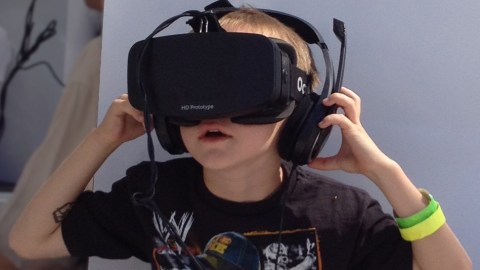In VR, boys and girls learn differently

- In a study, 33 girls preferred to learn from a young VR researcher named Marie — 33 boys did better with lessons from a robot drone
- It’s expected that the future of learning is VR
- Is it better to be guided by someone like you, or something else entirely?
Anyone who’s donned a virtual reality (VR) headset knows what an amazing experience it can be. Whether you find yourself reaching for a bowl of tea in a Mongolian yurt, pulling back on the controls of a jet fighter screaming through the sky, or taking the part of a character in some fantasy world, the technology’s immersive power is beyond cool — it can be profound. Little wonder then that educators are eager to bring VR to classrooms so that students can learn by virtual doing: Visit distant locales as they learn geography, float through the human blood stream in biology classes, and walk among and “touch” visualizations of math concepts, to name just a few of the intriguing possibilities.
That VR should have value in the education space seems obvious. But exactly how it can be more effectively used, being such a new medium, is largely unknown. Before precious school-budget dollars are spent, therefore, researchers are trying to understand how to realize the promise of VR for students. One such researcher is Guido Makransky of the University of Copenhagen. A study of his published In November 2018 in Journal of Computer Assisted Learning examines how well seventh- and eighth-grade students at a Danish science-talent school related to various types of virtual instructors. He found that, overall, girls did their best learning from a young, female researcher named Marie, while boys scored better taking instruction from a flying robot drone. Because of course.
A virtual classroom in the study
(Makransky, et al)
The study setup
The initial purpose of the research was to “determine whether boys and girls learn better when the characteristics of the pedagogical agent are matched to the gender of the learner while learning in immersive virtual reality.” As it turned out, they might have started with teachers matched to the same species, given the boys’ responses.
Makransky recruited 66 seventh- and eight-graders between the ages of 13 and 16. There were 33 from each level, and 33 of the cohort was female. 38 of the kids had previously tried VR. The tests occurred during VR workshops at two week-long summer science camps. Obviously, therefore, the children were preselected for their interest in science by virtue of their attendance at the camps.
The students were administered a pre-test, after which they were led into three stages of VR learning:
- In the first, they were given lessons via virtual tablets on which appeared theory, visualizations, pictures, and assignments.
- Second, they performed tasks in their virtual world, which contained, among other things, workbenches. They were tasked with removing inappropriate items from their “lab,” dealing with acid spills, and identifying hazardous situations.
- The third stage involved answering multiple-choice questions about lab safety.
Virtual Marie and her flying robot drone teaching colleague
(Makransky, et al)
The virtual teachers
The experiments were basically a competition between two virtual teachers, Marie, and the robot drone. They were both programmed to exhibit the same type of behaviors, as well as “micro-expressions when resting, such as eye and head movements to add an additional layer of realism, which was found to positively affect learning outcome.” Marie’s voice was synced to her lips. The droids’ speech was shown using the blue ring around its eye.
How’d they do?
When the researchers tabulated data from the pre-test, the students’ performance scores, and the results from the post-test, the gendered preferences were revealed. Makransky summed up his findings to the University of Copenhagen.
As for the girls:
We can see that students´ ability to identify with the pedagogical agent improves their level of learning. This gives us an exciting possibility to actually make education more appealing to the students. This is important, as children’s’ interest in school decreases in middle school, and there is specifically a desire to increase female students’ interest in science, technology, engineering and maths (STEM) subjects. Therefore, the possibility to engage girls is very appealing. In our opinion VR-program designers should use this knowledge to incorporate different types of pedagogical agents in VR for different types of students.
And the boys:
Our results show that the boys´ concentration and focus on the task rises when their virtual teacher is a non-traditional teaching figure like a robot or a drone. We also see these types of pedagogical agents are more effective in terms of the boys´ learning outcomes, possibly because they portray some of the superhero-qualities that appeal widely to boys, and because they resemble the agents boys are used to [interacting] with in computer games.
Obviously, a study such as this can’t definitely identify the individual preference of a single specific girl or boy, nor does it assume stereotypical behavior for all members of a gender. It takes a generalized look at young girls and boys preferences. It’s also worth noting that at least one other study found that the characteristics of a VR instructor may matter less as students get older. It’s no surprise that that there are surprises ahead. After all, we’re just at the dawn of a whole new era in education.





